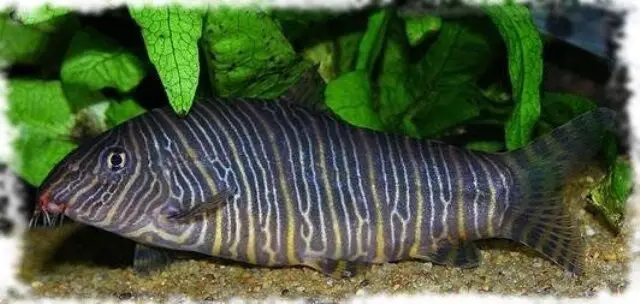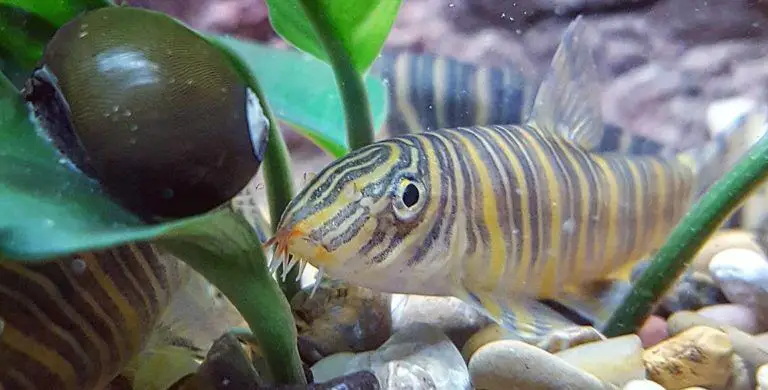Zebra Loach ( Botia Striata) is a beautiful small fish. Botia Striata does not require special care and conditions of detention, not too demanding on food. Therefore, it is often recommended for novice aquarists. But it is not so easy to find it on sale it is an endangered species.
- Fish size: 9 cm.
- Temperature: 21-26 ° C
- pH of water: 6.0-7.5
- Behavior: Peaceful
- Habitat layer: Bottom
- Flock: Staynaya
- Water type: Fresh
- Keeping in Aquarium: Easily
Also have other names Botia striatus, Botia striata kolhapurensis, Candystripe loach.

Table of Contents
Zebra Loach ( Botia Striata) Habitat and Description
The fish has been known since 1920. The homeland of the Botia Striata is South India the Tunga, Shivamagga rivers. According to the International Union for Conservation of Nature, the striped botsilia is endangered in the wild. The reason for the theme was environmental changes and a small natural area. Therefore, aquarists are advised to be interested in the origin of fish and to buy only those bred in captivity.
In an aquarium, a striped fight grows no more than 9 cm, in the wild, the length can be greater – up to 12 cm.The color is dark (blue, green, gray or black), the body is covered with multiple alternating transverse, clear stripes of silver or pale yellow.3.8Suitable for beginners4.2Small content3.3Mobility3.8
The abdomen is yellowish-golden, the fins are slightly yellowish, decorated with black dots. The head is blunt, with three pairs of antennae.
The color of the fish depends on the place of capture. The pattern of the Zebra Loach is very reminiscent of the hoofed animal of the same name, for which it was named so.
The fish must be handled carefully so as not to prick. On her body she has subocular spines hidden under the skin. But if the fish is under stress – for example, when it is taken out of the water, then it straightens its spines.
Young females are almost indistinguishable from males. But with age, they increase in size, and look larger in comparison with males of the same age.
Zebra Loach ( Botia Striata) Care and maintenace in Aquarium
The health and life expectancy of the striped fight depends on the correct equipment of the aquarium and the diet.
AQUARIUM
- The Zebra Loach are populated into the aquarium by 5-6 individuals at once. For such a small flock, a tank of about 100 liters is required. The bottom area should be sufficient to provide enough space for the entire flock. Various shelters are installed in the tank – driftwood, grottoes, stone structures.
- Sand mixed with pebbles is poured at the bottom, large boulders are added. Botia Striata is a bottom fish, so it loves to look for food in the ground. For this reason, the cover is chosen so that it does not injure the delicate organs of touch – the antennae near the oral cavity.
- In the wild, the striped fight is nocturnal. But in the aquarium, she gradually gets used to the new conditions, rebuilds to the daytime regime. Therefore, the lighting should be muted, diffused.
- Aquarium plants are chosen large, with powerful roots and wide leaves thrown onto the surface of the water – nymphea, gigantea vallisneria. Floating flora is allowed – pistia, riccia. You can decorate the aquarium with shade-loving aquacultures – anubias, mosses, ferns.
Zebra Loach (Botia Striata) prefers moderate currents, therefore, a productive filtration system with a pump will be required. The equipment will ensure the cleanliness and oxygen supply. Change up to 35% of the water volume weekly. The walls of the aquarium are regularly cleaned of organic waste.
Zebra Loach ( Botia Striata) Feeding and nutrition
In general, the fish is unpretentious in nutrition, although with age, capriciousness sometimes manifests itself.
The striatal bots are carnivorous. In the wild, the diet is based on aquatic insects, crustaceans, and zooplankton living at the bottom of water bodies.
Fish in the aquarium are fed with sinking food. It can be frozen bloodworms, brine shrimp, daphnia. Ready-made products in the form of flakes and granules are well eaten. Pieces of earthworms are a good source of protein, but they are only occasionally yielded.
Homemade food prepared with gelatin is recommended. Botia Striata is eaten by aquatic snails, but cannot be used to decontaminate an aquarium.
It is important to feed the fish with herbal supplements. Otherwise, it will eat aquarium plants with small leaves.
Botia Striata diseases
- Botia striata has a fairly strong immune system. Diseases usually develop mainly due to trauma or due to inappropriate conditions of detention. If symptoms of any disease appear, first of all, the condition of the water is checked.
- You also need to make sure that the level of toxic nitrogenous substances is not exceeded. If violations are found, the water is changed first. Then treatment is started.
- Most often, the fight affects ichthyophthyriosis. White small specks appear on the body, resembling semolina. Ciliates can enter the aquarium with food, plants, soil that have not undergone the disinfection procedure.
The most dangerous period is spring-summer when ciliates are actively multiplying.
Ichthyophthyroidism is treated by transplanting into a separate aquarium, without algae and soil. Also used methylene blue, kitchen salt. In case of severe infection, Bitsilin-5 is used.
Another disease that affects striped fights is hexamitosis. The most common cause of this is infection with flagellate Spironucleus. Its symptom symptoms are weight loss, the appearance of ulcers and erosions on the lateral lines, an increase in the size of the head relative to the body – the “pinhead” effect, refusal to feed. Affected fish hides in the far corners.
There are several reasons:
- poor water quality, many stagnant zones in the aquarium;
- abrupt change of feed;
- high crowding;
- postponed stress, transportation;
- keeping fish of different sizes.
Only oral administration of drugs is effective against this disease.
Aquarists have noticed that during the battles for dominance, which occur when an individual is introduced to a new aquarium when adding neighbors, the dominant individual can lose its expressiveness of the pattern or become discolored. This phenomenon is also called “graying”.
Zebra Loach ( Botia Striata) Breeding and reproduction
Zebra Loach are not naturally bred in captivity. Only hormonal injections will help to get offspring.
Recently, commercial breeding has reached a new level. Therefore, many hybrids have appeared on the market. So, the Botia Striata is crossed with the histrionic battle and the clown battle. For hybrid samples, a different pattern is possible – circles, spots. You can recognize the “thoroughbred” fish by the red mouth opening.
What fish can live with zebra loaches?
Zebra Loach is famous for its peaceful disposition. She most often fights in solitary confinement. If you buy only 2-3 individuals, then the most aggressive fish can suppress congeners so much that they refuse food.
The Zebra Loach ( Botia Striata) sometimes attacks other benthic species of aquarium inhabitants. Therefore, it is better not to add small fish-like corridors to the aquarium.
Slow swimming fish with long fins – guppies, bettas, cichlids should be avoided as the zebra fight can damage them.

In general, Zebra Loach is quite active. They love to frolic with peaceful neighbors of the same size. Suitable:
- luciosomes
- barbs
- Labeo two-color
- seaweed siamese
- garra
- catfish
“The Zebra Loach is a fish with character. We bought one, and wanted to add it to the group of friends - also battles, but marble ones. Strata was not happy, and began to chase the hooked fish. Until that time, she periodically attacks them, especially during feeding. "
Zebra Loach ( Botia Striata) Similar Species
Botia Striata Similar fish species:
- fight clownbattle marble
- modest fight
- Morlet’s fight
- fight of birdmore
- fight pulhra
- tiger fight
- fight histrionics
It is not so easy to find a Zebra Loach on sale, and sometimes a marble battle is given for it.
Zebra Loach life tips from experts
- It is useful to add dried plant leaves to the aquarium for example, Indian almonds. Its pigments will color the water in a brownish tint, as in its natural habitat.
- For an aquarium, it is advised to choose a filter with a water flow rate of 4-5 times the volume of the aquarium. Then the water will always be clean and oxygenated.
- Botia Striata love to explore the environment. Therefore, the decor that is used in the aquarium is chosen without sharp edges. There should be no small gaps between the elements, in which the fish can get stuck. It is better to fill them with silicone sealant.
Zebra Loach Interesting Facts
Aquarists have noticed that the character of an alpha individual can influence the character of an entire group of fish. Usually, the strongest, most aggressive female plays the leading role.
Inheritance is an interesting behavior seen among striped battles. It consists in the fact that the young individual swims next to the older member of the flock, and repeats every movement he sees.
It is noteworthy that up to 3-4 fry can follow one adult fight. Scientists cannot yet explain this phenomenon.
Presumably, this is how wild relatives behave when rivers overflow. This behavior can be a way of communication.
Botia Striata often falls asleep belly up. This scares inexperienced owners: they think that the pet is dead.
Species researchers believe that sound is an important factor in communication between flock members. When the fish are excited, they increase in volume and click slightly audibly. The origin of these sounds is still poorly understood. But it is believed that they can occur due to throat teeth.
Botia striata is an interesting species of fish. Such pets are very interesting to watch, and easy to care for. They will decorate any aquarium with their beauty.